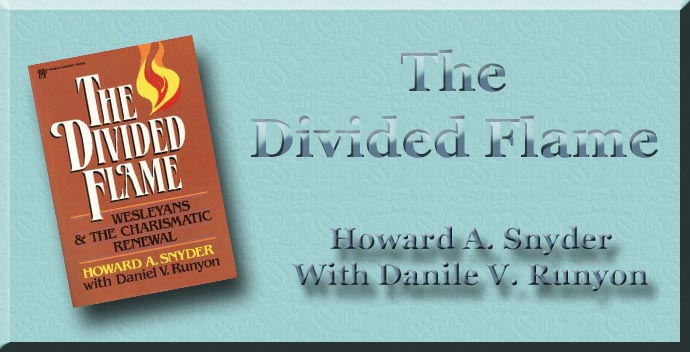INTRODUCTION
Words make a difference. Words like “holiness,”
“pentecostal,” and “charismatic” have sometimes been fighting words. But
they can also serve as bridges to broader understanding.
The word “charismatic” serves the contemporary
Charismatic Movement as “holiness” did John Wesley’s most lively descendants
in the nineteenth century. Key words and concepts like these embody the
organizing center of a movement. Because of this, “charismatic”— like “holiness”
and “pentecostal”—quickly becomes a slippery word, meaning different things
to different people. Like so many terms with a biblical base, however,
it is too good a word to be abandoned because of differing meanings and
connotations. In banning the word we may also close the door to important
truth or restrict the free flow of the Holy Spirit among us.
Anyone who feels that the word “charismatic”
is too tainted or loaded to be useful today might consider such biblical
terms as “presbyterian,” “episcopal,” “baptist,” and “ecumenical.” Like
“charismatic,” these words come directly from New Testament Greek. Their
modern English connotations don’t warrant dropping such words from our
vocabulary. Rather, we should rediscover and reaffirm their true biblical
significance. We should watch for meanings we may be missing.
It is fully appropriate, therefore, for
Wesleyans to have dialogue with Charismatic Christianity. By “Charismatic
Christianity” we mean primarily the contemporary Charismatic Movement in
its various forms and secondarily its Pentecostal antecedents. Despite
the increasing awareness of common Charismatic, Pentecostal, and Holiness
roots in the Wesleyan Revival, to date little dialogue has developed between
contemporary Wesleyans and Charismatics. Such dialogue is needed today.
In this book we hope to show that Wesleyans
have both something to learn from and something to say to contemporary
Charismatics. We also want to recognize that God is using the Charismatic
Movement today. To recognize this is a thoroughly Wesleyan attitude.
How does a Wesleyan dialogue with Charismatic
Christianity? Rather than comparing our theology or practice point by point,
we have chosen to address the central question that Charismatic
Christianity raises for us: In what sense is Christian experience, or
the church, charismatic? If the Charismatic Movement raises valid biblical
questions for us—and it does—then it is more important to deal with those
questions than merely to catalog the pluses or minuses of the movement.
First we must investigate the question of
the charismatic nature of the church. Then we will ask whether Wesleyanism
is a charismatic movement, examining Wesley’s theology and the Methodist
and Holiness movements in the light of Scripture. Finally we will comment
on Wesleyan and Charismatic Christianity today and offer some suggestions
in the direction of a biblical Wesleyan ecclesiology—since the charismatic
emphasis inevitably raises the question of church structure and practice.
While this book is not primarily an historical
study, we have supplied enough historical perspective (we trust) to make
our theological and practical analyses intelligible.
In John 17 Jesus prayed that the church
might be one so that the world would know him. This prayer excludes neither
Wesleyan nor Charismatic believers. It is our conviction that Jesus was
more concerned about the unity of the church than most Christians are today.
Our hope is that this book may lead to greater unity among believers, thereby
advancing the cause of Christ, the church, and the kingdom.
Howard A. Snyder
Chicago, Illinois
Daniel V. Runyon
Spring Arbor, Michigan |



 Home
Home What's New
What's New Bible
Bible Photos
Photos Hiking
Hiking E-Books
E-Books Genealogy
Genealogy Profile
Free Plug-ins You May Need
Profile
Free Plug-ins You May Need
 Get Java
Get Java.png) Get Flash
Get Flash Get 7-Zip
Get 7-Zip Get Acrobat Reader
Get Acrobat Reader Get TheWORD
Get TheWORD